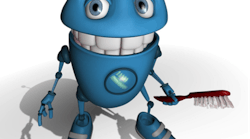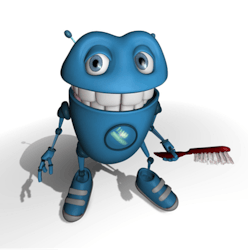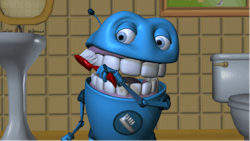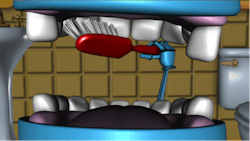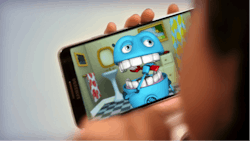Brush Up, a research-tested game that includes an app and a Bluetooth-wired toothbrush, helps pediatric patients learn proper tooth brushing.
In most dental offices, toothbrush training is not fun – for the child nor for the dental staff. It is not uncommon for dentists to avoid the issue by delegating a staff member, who is usually a hygienist, to handle it. As much as hygienists may try and as much as they may enjoy providing toothbrush training to children, they often report that they are frustrated by poor responses to the training. They often can’t get through to the child who sits dutifully in the dental chair, either nodding in affirmation or just staring glassy-eyed. In the long run, that child goes home and resumes the old brushing habits (if any at all).
Toothbrush training is handled in a variety of ways. At one extreme is the stern lecture with the graphic description of the consequences of failure. At the other is the coaxing tone of a loving and indulgent mother. The tone and content are usually indicative of the perspective of the adult. For example, a hygienist – aware of the role of good brushing in dental health – will emphasize technique.
It is essential to consider the child’s experience. S/he is in an uncomfortable environment (the dental office, a large mechanical chair, an unfamiliar adult), being told to do something that s/he generally is not motivated to do. Is it any wonder that teaching a child under these circumstances is so difficult? The child hears the words, but the words do not resonate.
Few in the dental profession are able to get inside the head of a child. No amount of urging, scolding, cajoling, or bribing will make it easy to cross this barrier. The hygienist or staff member providing the training must ask, “What is this child thinking right now? What would grab his/her attention? What can I say that would be on his/her level of understanding?”
The goals of teaching good brushing are twofold. The first goal is to instruct the child in proper technique so that debris is successfully removed from the teeth. The second goal is for the child to develop a regular habit.
To help dental professionals achieve these goals, an Atlanta-based learning studio called GamesThatWork developed Brush Up, a game that includes an app and a special toothbrush. Since imposing toothbrush instruction on children can be futile, the game offers a self-teaching activity with child-oriented language and images to help children learn the modified Bass-Stillman technique. Children might not want to learn how to brush their teeth, but they will want to play games. If the end result of playing the game is the development of good brushing methods and the creation of a habit through regular gameplay, then the learning goals have been met. This is exactly what happens when children play Brush Up.
How Brush Up works
The key to the success of this game lies in the toothbrush. It includes electronic sensors and wireless Bluetooth technology to guide and assess the child’s brushing. The handle, which can accept replacement brush heads, features a model of Budd, the cartoon character who serves as the child’s on-screen tooth brushing guide.
Budd, the cartoon brushing guide
Budd uses simple and understandable terms for the teeth such as “biters” (incisors), “chewers” (cuspids), and “crunchers” (molars). Surfaces are “outside” (buccal or labial) or “inside” (lingual). “Right” and “left” are avoided. Each brush stroke is set to a song that is easy for the child to appreciate and remember. The song guides the child through each step of brushing.
At the start of the game, Budd picks up a toothbrush and tells the child to grasp his own. Throughout the game, Budd only takes actions that the child is also capable of making. The simple and clear representation of Budd’s mouth helps Budd show the child the placement and use of the brush. Children easily mimic this. Budd combines demonstrative anatomy with a humanlike appearance. He rolls his eyes kindly, smiles, and presents a friendly face to the child.
Budd demonstrates proper brushing technique
With the instructional song as a guide, Budd and the child begin the brushing process. The electronics in the brush translate motion to the screen so that improper brushing movements can be corrected. The child places the brush at the proper angle, scrubs, and sweeps in time with the song, moving around the arch to cover all the teeth. Dramatically, when the labial and buccal aspects of the teeth have been cleansed, Budd turns around to reveal that the back of his head is open and that most of his head floats above his lower jaw. This allows the child to get a wonderfully clear representation of the lingual surfaces. As Budd guides the child, green material on the teeth disappears. The better the child brushes, the more material is removed.
Budd brushes his lingual surfaces
At the end of the game, the child evaluates his/her brushing. The game also evaluates the child based on the sensor readings and awards points for successful brushing. The points can be used to purchase in-game treasures and toys. Collecting these prizes motivates the child for regular brushing and long-term engagement with the game.
The game typically ends with a few words from the child’s dentist or hygienist. Using YouTube or Instagram, a dental practice can post five videos to conclude the game. These clips – only a few seconds in length – congratulate, encourage, or correct the player. The game uses its data to select the most appropriate message.
Evaluation of the game’s efficacy
A dental hygiene scientist, Joyce Flores of Old Dominion University, conducted a study, with analysis by Traci Leong, PhD, a biostatistician from Emory University.
A blind researcher evaluated the toothbrush techniques of 34 children between the ages of 5 and 6 as they brushed in the lab with no guidance or timer. Except for members of the control group, the children were sent home with the game and instrumented toothbrush to play the game each night. After this, they returned to the lab so changes in brushing techniques could be measured.
Using the mean of nine brushing evaluation metrics, the effects of the game were measured. Where 1.0 represented flawless brushing, the baseline score was 0.10. The control group’s score was similar to the baseline score at 0.15. The children who played the game for seven days scored 0.51, and those who played for 14 days scored 0.81.
A similar effect occurred when the time spent on each tooth surface was measured. Video analysis was used to determine the amount of time spent in each of 16 sectors of the mouth. Initially, children only brushed the front surface of the incisors and some of the buccal surface on the non-dominant side. The only occlusal surface brushed was that of the lower teeth on the non-dominant side. These are the surfaces that are easiest to see and most comfortable to reach.
When the time spent on each tooth surface was measured again at seven and 14 days, the children increased the time spent brushing and, more importantly, distributed the time spent brushing around all quadrants of the mouth. The most dramatic change involved the time spent on the lingual surfaces. Originally completely neglected by every child, the lingual surfaces were brushed consistently after 14 days of gameplay.
One year later, the same children were called back to the lab. The 25 who returned had not played the game at all during the previous twelve months. They brushed again in the lab without any guidance or timer. Their total brushing time had dropped by 45%, but the time was still distributed across the quadrants of the mouth. Most notably, they continued to brush carefully the previously unknown lingual surfaces.
(yellow bars indicate lingual surfaces)
The game was successful in its immediate goal of teaching good tooth brushing. As the follow-up study showed, the habits learned in two weeks were not forgotten a year later. How many in-office teaching efforts can claim that kind of success?
To summarize, good toothbrush training of young children doesn’t rely on genuinely friendly lecturing, cute toothbrushes, or colorful toothpaste. Parents, who are generally not equipped to do the teaching, cannot be expected to change this. The child is the most significant person involved in the process when s/he is given the chance. Brush Up provides this chance and makes learning fun.
A child plays Brush Up
Finally, using an effective and advanced replacement for the traditional tooth brushing talk leads to many benefits in the dental office:
1. Parents and the public identify the dental practice as one that helps children to develop good home care habits. This enhances the public image of the practice and leads to growth. Adults always accompany pediatric patients, and special treatment of children does not go unnoticed.
2. The Brush Up program provides a link to the office that appears each time the game is played, and the dentist or hygienist speaks to the child twice a day, which supersedes the twice-per-year norm.
3. Brush Up has the potential of being another profit center for the practice. The Brush Up toothbrushes, purchased at a wholesale price, can be sold to parents who desire the full benefits of the game to be available in their homes.
4. By far, the most important benefit is that pediatric patients are provided with the means to develop good home care habits and techniques. Frustration and failure can create a positive, effective, and fun path to oral health.
For more information, visit brushupgame.com.
Editor's Note: Have you tried this product? Tell us what you think! Comment below or join the discussion on DentistryIQ's Facebook or Twitter page. Want to submit an article or product review? Find our contact information here.
